I started this project five years ago with a simple question: how can I provide for my children’s future, whilst ensuring they have a future? That means finding a solution for life that’s reconciled with climate change, but in a way that creates wealth and positive returns. Technologies have done us all favors in this regard and I found myself investing in a few simple measures early on that allowed us to save for bigger changes, which saved more money. We saved as much of those savings each month as we could so we had a pot of money that was growing increasingly quickly with money we otherwise would have just spend on light, heat and transport. They were things like replacing our petrol car with a second hand electric car, cycling rather than owning a second car, installing double/triple glazed windows, installing LEDs throughout the house, and adding attic insulation.
Six months ago, we took these accumulated energy savings and invested in achieving a low energy cost household. We wrapped the house in insulation, we switched the heating from gas heating to an electric heat pump, and we installed a 5.9 kW Solar PV array. Additionally, we replaced the gas cooker hobs with electric induction hobs (Ikea sell them starting at €39) to fully remove gas bills from our house forever. We had already switched to an electric car from our old petrol car. Our house now requires a lot less heat, that heat comes from an electric heat pump, and for a lot of the year, the electricity powering it (and our car) comes from Solar panels on the roof.
All of this is in a bog-standard 1980s three bed semi-detached house originally built with minimal thought to running costs. If we can do it, anyone can. Five years ago, our energy costs across our car, heating, hot water and electricity totaled $5,700 (€4,703.56) per year. Now it’s $950 (€778) a year.
Had we changed nothing and continued with our 2015 baseline, over the next 10 years we would have spent $57,000 on the energy required for our lives. Instead, with the changes we’ve made, we’ll spend $9,500, freeing up $47,500 and giving us a lot more financial stability. One of the key lessons we’ve taken from the unpredictable nature of the last two years is that finding ways to earn more money is really hard, and when you do, you pay a lot of those increased earnings in tax. We’ve realized it’s a hell of a lot easier to spend less money that it is to earn more, and the net effect on our cashflow is the same.
SolarPV
We had already installed a 2.5kW SolarPV system on the front of our house three years ago, but as we now are heating our house with electricity, and powering our car with electricity, I saw it as a financially positive investment to increase the size of our SolarPV system to 5.9kW by adding extra panels on our flat back roof.
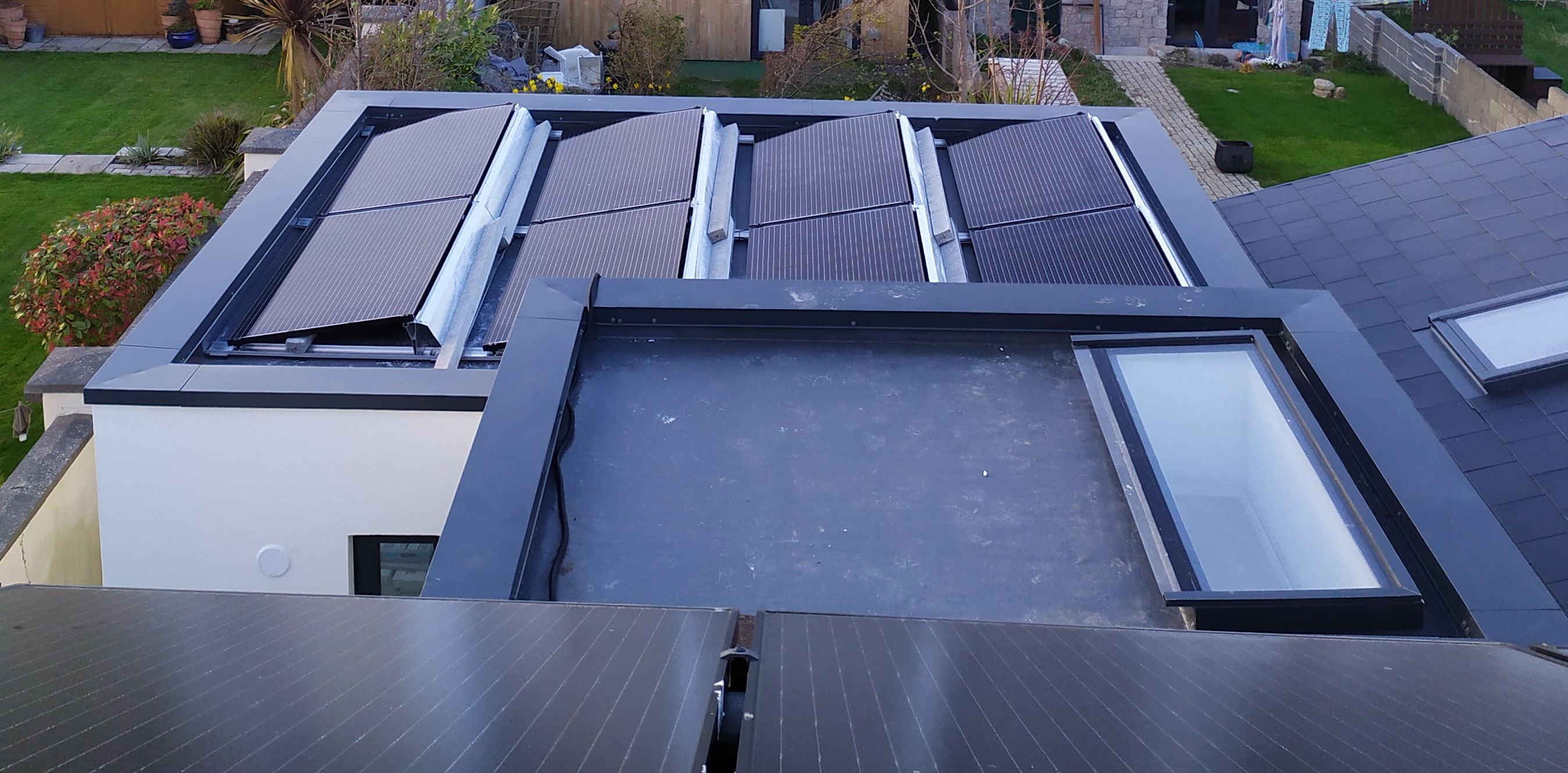
Our electricity cost varies depending on the time of day. Our day rate is $0.23 / kWh (€0.1874/kWh) and our night rate is $0.114 / kWh (€0.0927/kWh). Our SolarPV system will generate 4,260 kWh per year. The battery soaks up almost all export, but I think we’ll export about 250 kWh per year, mostly during stretches of long blue-sky days in May/June. That leaves 4,260-250 = 4,010 kWh per year that we’ll consume, offsetting the need to pay for it. Taking a simple day rate calculation for the value of this electricity is $0.23 * 4010 = $922.30 per year. The figure is more complicated for two main reasons:
(1) Detracting from this net impact cost, some of the electricity consumption the SolarPV offsets, we would otherwise have consumed at night rate (€0.0927). I estimate this to be about 50%. So (4010 * .5 * €0.1874) + (4010 * .5 * €0.0927) = $689.84 (€561.60). The SolarPV system cost €5,198 ($6,300) after the €1,950 grant so the yearly ROI is €561.60 / €5,198 = 10.8% . It’s warrantied for 20 years, so the full payback of investing in solar will be in the region of 561.60 * 20 = €11,232 ($13,796.83). Higher if energy prices go up, which they are very likely to do.
(2) If your original baseline is a petrol or diesel car, and you switch to solar, putting the solar generated electricity into an electric car would save more as it is saving money you otherwise would have been spending on petrol. A litre of Petrol contains 12.8889 kWh, burned in an internal combustion engine with a max. efficiency of 38%, so your €1.26 litre of petrol gets you about 4.8kWh, or €0.2625 / kWh. So if you’re doing calculations on making a big switch to cut costs in your life by switching to SolarPV + an Electric Car, and you put 2,000kWh of solar into your car, that will give you an extra bonus saving of 2,000 * €0.2625 = €525.00 ($644.88)
Here’s the generation from our SolarPV system, and energy consumption of the house, from a day in May – solar generated 23.7kWh of electricity. We consumed 21.9kWh of that between powering the house, heating water in the hot water tank via the Heat Pump, and the excess went into the battery. The electricity stored in the battery continued to power energy consumption of the house after the sun went down. So of the total of 21.9kWh we used that day, we imported only 2.7kWh from the grid. Our electricity bill in May was €15.18 (about $17) – it’s quite remarkable to me that on sunnier months like this, we can power our house, transport and heat almost entirely from solar.
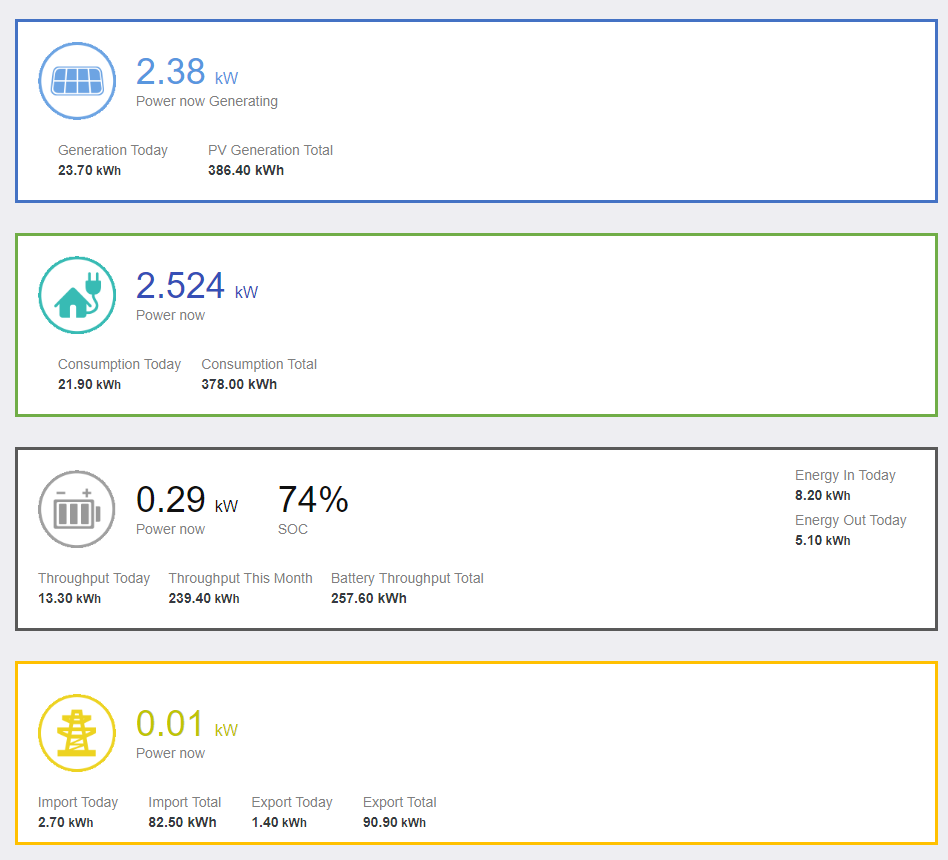
Here’s a day in May – solar generated 23.7kWh of electricity. We consumed 21.9kWh of that between powering the house, heating water in the hot water tank via the Heat Pump, and the excess went into the battery.
If you’re working out a solar installation for your house, look to see what grants and other financial incentives are available. I’m based in Ireland (officially the least sunny place in the world, and SolarPV is still a positive investment!), where grants are available from the SEAI which pay you €3,000 ($3,500) for a 4kWp system with a battery, €2,400 ($3,000) for a 4kWp system with no battery, and €1,800 ($2,200) for 2kWp system of about 8 panels. Additionally, many places around the world will also now pay you for each kWh of electricity you feed back into the grid from your SolarPV system, referred to as “net metering”, or a “feed in tariff”. Several states in the US, for example, operate net metering programs, and all countries in the EU are mandated to have a feed in tariff scheme in place by the June 2021. So not only will every kWh of SolarPV you consume reduce your costs, but you can also create an additional revenue stream by selling excess Solar electricity back to the grid.
Battery
The battery saves money in two ways: in summer, it stores excess solar which would otherwise have been exported. Along these lines:

The battery allows you to store Solar generated at peak times to power your house into the evening and through the night.
Looking through the summer figures, the resultant stored solar we used about two third of the time during the day rate (€0.18 / kWh) and about a third during the nighttime (€0.09 / kWh). We stored an average of about 5 kWh per day over those 6 months – maxing out the 8.2kWh of storage almost every day during May, June and July, and averaging about 3kWh a day in April, August and September. That translated to a saving of 6 * 30 * .66 * 5 * €0.18 = €106.92 +
6 * 30 * .33 * 5 * €0.09 = €26.73 . So €106.92 + €26.73 = €133.65 ($164.17) per year in the summer months for the battery.
Secondly, in winter, we can charge it at the night rate (€0.09) and use it to power the house to avoid the day rate (€0.18), saving €0.09 per kWh. We do this for the 6 less sunny months of the year, offsetting 8.2kWh of daytime consumption every day, so saving 6 winter months * 30 days per month * 8.2kWh * €0.09 / kWh saving = €132.84 ($163.17) per year.

In winter, you can charge a battery over night at a cheap night rate electricity to power the house during the day, avoiding more expensive daytime electricity.
The battery thus saves €133.65 + €132.84 = €266.49 ($327.34) per year. The battery’s net cost was €1900 which gives a 1900 / 266.49 = 7.1297 year payback of the battery, or a 14% yearly return (€266.49 / €1,900) if the full cost of the battery is written off at the end of the 7 years.
So, right now the battery is a marginal investment depending on whether you are in an area which pays for the excess solar you send back to the grid. The value of a battery will likely increase in value over time when homes are rewarded for providing flexibility to the grid. Additionally, the battery provides one other advantage – continued power in the event of a grid blackout. The SolarPV and battery inverter system comes with a power back-up connection which provides a power outlet which will continue to work if the grid goes down. This means that if the grid goes down, we can continue to power key appliances and the car indefinitely with solar in the event of a prolonged grid blackout. This is the backup system with the power turned off to the house:
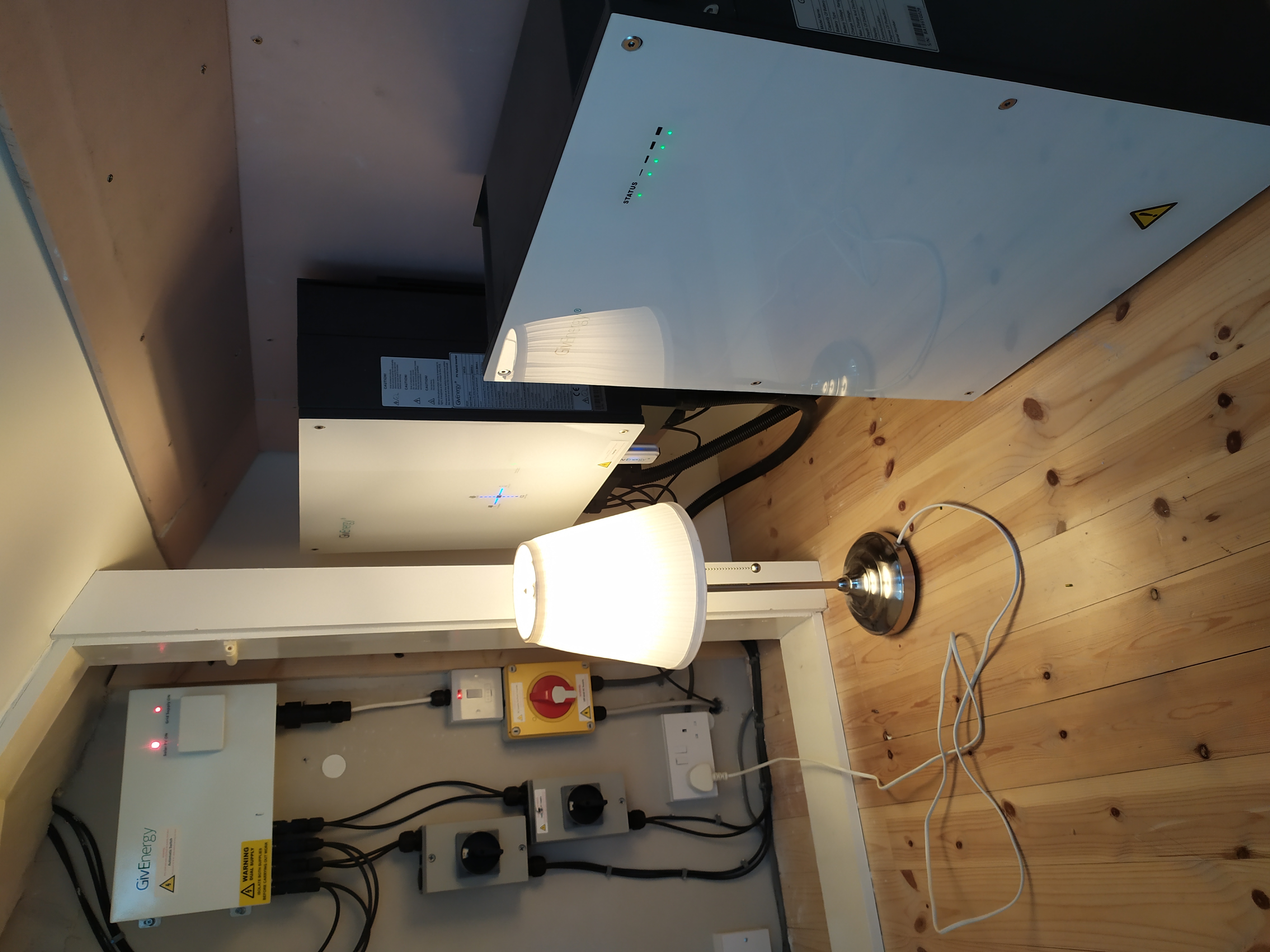
The Battery and Solar Inverter has a backup power socket which allows you to continue powering the house during a blackout, and in the event of an extended blackout, you can continue powering the house indefinitely with the solar generation.
Insulation
Insulation is not the most exciting of things to do but it is by far the most important of anything listed here. Before installing SolarPV or a Heat Pump, your house should be really well insulated. A few years ago, we replaced all of our windows with double glazed windows, installed a new airtight front door to stop drafts and insulated the attic. This time we finished the job. We wrapped (e.g. installed external insulation) on the side and back of the house, and installed internal insulation on the rooms at the front of the house (as modifying the front of the house would have required planning permission). The insulation cost €9,300 ($11,000) with the €4,500 ($5,500) grant, but it has utterly transformed the house from a drafty cowboy build three bed semi into a warm and cozy house that stays at a constant temperature which will require drastically less energy to heat it for the next 50-60 years of its lifespan. It used to be like a leaky bucket into which we had to constantly pump heat (e.g. money) into to keep heated. Now it’s cozy and warm through winter without requiring much heat input to keep it that way.
Heat Pumps
A heat pump is quite a miraculous machine. Other heating systems, such as gas boilers, wood stoves and oil fired boilers are 50-80% efficient. That is to say 50-80% of the energy you put into them in the form of fuel comes out as useful heat. Heat Pumps can be 200-500% efficient by virtue of that fact that they are not creating heat, they are simply pumping it in from the outside. For every one watt of electricity you power the Heat Pump with, it delivers 2-5 watts of heat into your house. The result is a heating system which is incredibly energy efficient. Couple it with a SolarPV system on your roof and when the sun is shining, you have ultra-efficient, completely free heating and hot water.
Heat Pumps work the same way that a fridge does, but in reverse. A fridge has a loop of piping that runs inside and outside of the fridge. It uses a valve to compress a fluid inside the pipe inside your fridge. As the liquid becomes more dense, it sucks in heat from the air cooling down the air in the fridge. A pump keeps the fluid moving around the loop. Another valve outside the fridge expands the liquid, and as it expands, it can hold less heat, so it dumps the heat it absorbed inside the fridge outside the back. This keeps the fridge cool inside. A heat pump heating system is exactly the same but in reverse. It uses two valves and an electric pump to pump a liquid around in a loop.
The Heat Pump we installed is a Hitachi R32 Yutaki-SCombi 2 5HP 200L. The Coefficient of Performance (unit of heat energy out / unit of electrical energy to power it) varies with a few factors, such as the outside temperature and the temperature you are heating water to. For 35C water, the CoP varies from 2.7 (outside temp of -7C) to 8.35 (outside temperature of 12C). For 55C water, it goes from 1.85 (-7C outside temperature) to 6.35 (outside temp of 12C). It’s listed with an all up CoP of 4.4 here. This is the full CoP table and other specs of the system:
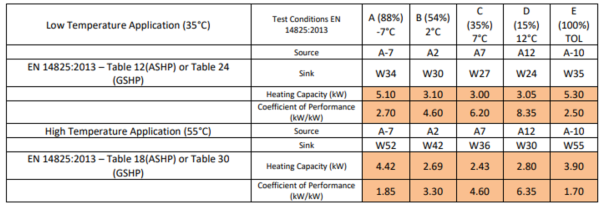
The full specs of the Heat Pump we installed. It has a CoP of 4.4, meaning for every 1 watt of electricity it consumed, it pumps 4.4 watts of heat into the house.
So that means for every 1 watt of electricity our heat pump consumes, it’s pumping 4.4 watts of hot water into the hot water tank, or out into the radiators.
The Heat Pump consists of a fan unit which sits outside, a fridge-sized inside unit that sits inside (replacing the gas boiler), and a 200l hot water tank. The water tank will replace an immersion hot water tank, as it does the same thing with 25% of the electricity. We mounted the fan unit up on the side of the house so it was out of the way:
Since installing the heat pump in March of this year, we have never run out of hot water – that includes showers, baths for the kids, washing and general usage all day while we were home during the lockdown, so I would say we have well and truly tested the capacity of the system and it’s come up trumps.
We installed underfloor heating on the ground floor and this results in a more efficient use of the heat pump. It allows us to run the heat pump to store heat in the floor of the house during the night or when there is excess solar generation. The floor stores a lot of heat and releases it slowly, so it will effectively heat the house for days. Underfloor heating is surprisingly simple – basically, put down insulation, put down a big loop of pipes and pour two inches of concrete on top:
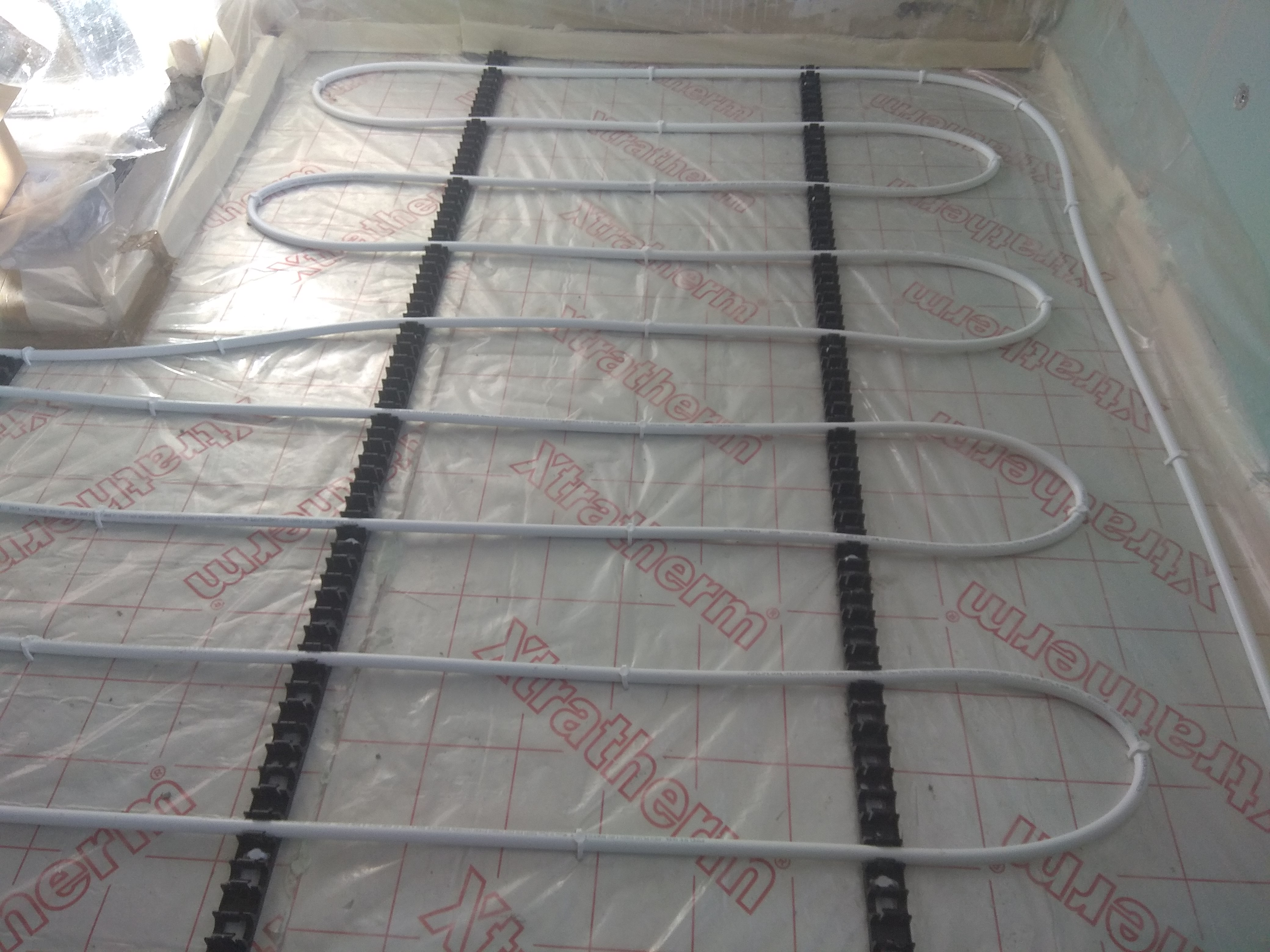
Underfloor heating is surprisingly simple – basically, put down insulation, put down a big loop of pipes and pour two inches of concrete on top
Underfloor heating isn’t essential however. Two households we know have recently switched over to Heat Pumps from gas and oil heating respectively, without underfloor heating. They did change their radiators to Heat Pump radiators which are more effective at distributing heat. We installed these upstairs replacing the old radiators:
One other attribute of a heat pump, though we’ll probably never have need for it in Ireland, is that if it gets too hot in summer, a heat pump can run in reverse and act as air conditioning to cool down the house. I asked the installer about this and it does require the addition of a “condensation kit” to deal with condensing water if you put it into cooling mode, which costs about €500 ($600) to add. Still, might be useful if summers get a lot warmer in the coming years. And it is certainly a serious advantage to consider in hotter countries.
How does a Heat Pump compare in running costs with Natural Gas and Oil?
This requires some math to figure out, so I’ll start with the conclusion: a Heat Pump is about half the running costs of the next cheapest alternative, natural gas, and cheaper still than oil or other forms of heating.
Because the efficiencies are so different, the input costs don’t really make sense to compare. When heating your house, the thing that actually matters is the cost of delivered heat, so I think the right measure for us to compare is € / kWh of delivered heat. If you can get gas for €0.05/kWh ($0.06/kWh) with a gas boiler with an efficiency of 80%, then your cost of delivered heat is €0.05 * (1/0.8) = €0.06 / kWh of delivered heat ($0.07/kWh). If Oil costs about €0.07/kWh, then it will similarly cost about €0.08 / kWh of delivered heat ($0.09/kWh)
We next need to work out our average cost of electricity for the Heat Pump. So a quick delve into the cost of electricity from the SolarPV array. It generates 4,260 kWh per year, warrantied for 20 years, 4,260 kWh * 20 = 85,200kWh over it’s warrantied lifetime, €5,198 / 85,200kWh = €0.06 / kWh. I would say we’re powering the Heat Pump with a mix of SolarPV, Night Rate electricity and day time electricity roughly equally, so the average electricity cost for the Heat Pump is – ( (€0.06 * .33) + (€0.08 * .33) +(€0.19 * .33) ) = €0.11 / kWh on average.
For a heat pump with an efficiency of 440% (e.g. a CoP of 4.4 meaning for every 1kWh of electricity it consumed, it pumps 4.4kWh of heat into your house), at an electricity cost of €0.11 / kWh means €0.11 * (1/4.4) = €0.03 / kWh of delivered heat.
So a heat pump is roughly half the cost to run, at €0.03 / kWh of delivered heat, to gas at €0.06/kWh of delivered heat or to oil at €0.08 / kWh of delivered heat.
For a system that will be heating your house for the next 30-40 years, assuming you have an average heating consumption of about 7,000 kWh a year like us, that will return a saving to you of $10,000-$20,000 over that time. More if natural gas or associated Carbon taxes, increase in price.. Which they are very likely to do.
Why are we paying for someone else’s Carbon?
A quick aside on Carbon Taxes mentioned above – Carbon Taxes are not really a tax, they’re just something that should always have been included in the price. Right now, the full cost of burning fossil fuels is not included in the price you can buy them for because most of the cost of burning fossil fuels, which is the cost to deal with the pollution they create, is socialised onto everyone rather than being paid by the user. It’s funny to think that fossil fuel advocates are actually espousing socialism when they reject having the polluter pay for Carbon, preferring for the cost to be socialised rather than pay it themselves. In any case, it’s quite impressive that SolarPV and Wind are both now cheaper than fossil fuels in most parts of the world even when fossil fuels like natural gas are subsidised by socialising the cost of their pollution onto future generations. So if someone objects to a Carbon tax or Cap and Trade scheme, it’s worth asking why exactly they think the cost of pollution should be socialised onto everyone when it’s only the person consuming the fossil fuel who gains the benefit or profit from doing so
Emissions
Driving our gasoline (petrol) car used to release 2,600 kgCO2 per year. Switching to an electric car reduced that by 1,630 kg CO2 per year to 970.9 kg CO2. But looking back at my math at the time – before we installed SolarPV, we were charging it year round with electricity from the grid. A few things have changed that for the better since:
(1) The electricity grid in Ireland, like most countries around the world, has continued to go green, adding a lot of renewable energy capacity in the last 5 years and retiring several coal and turf power plants. It’s now mostly renewables and gas.
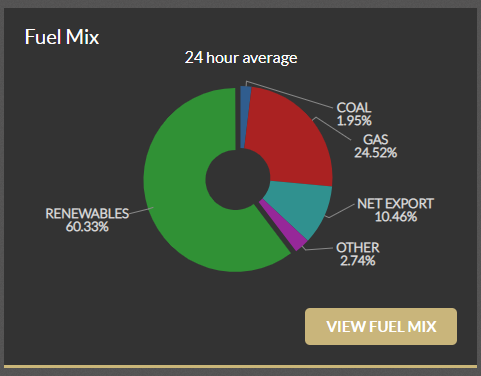
The electricity grid powering our house and car on the day I wrote this blog post – more than 60% of the electricity was coming from renewables. This is increasingly common around the world as investing in new renewable energy is now cheaper than simply running existing fossil fuel plants in many parts of the world
(2) In summer, we are no longer charging our car from the grid, which has an average emissions intensity of 389 gCO2 / kWh, we are charging it from our SolarPV, which have an emissions intensity of about 18 gCO2 / kWh (this is the emissions released during their manufacture and transport divided by all of the kWh they will generate in their lifetimes). Because we installed an 8.2kWh battery, even if the car isn’t plugged in during the day, we can that much solar into it via the battery in the evenings, which amounts to about 50km in an older Leaf.
(3) As renewables installed in Ireland is mostly wind, and it’s windier in the winter in Ireland, that means the grid releases much lower CO2 per kWh in winter than it does in summer on average. Renewables now average 37% in the winter months, with an average CO2 intensity of about 270g/kWh.
So this means that we now charge our car for six months with an average of 270gCO2/kWh and the other six months with an average emissions of 18 gCO2 / kWh. We drive about 300km per week, which consumes 48kWh of electricity. So the net emissions are 48 * .270 * 4 * 6 = 311.04kgCO2 (6 months of winter) + 48 * .018 * 4 * 6 = 20.736kg CO2 (six months of summer) . So our driving is down to 311.04 + 20.736 = 331.776kg, a whopping 2,268.224kgCO2 reduction on our old petrol car. It also shows that as time goes on, and grid is increasingly powered by renewables, electric cars will get cleaner and cleaner.
The installation of our heat pump has also removed all gas that we used to burn. We used to spend €793 a year on gas at €0.09 / kWh. So we used roughly €793 / €0.09 = 8,811.11 kWh of gas yearly. Gas emits .23kg CO2 per kWh from a gas boiler with reasonable efficiency, so our gas usage was emitting 8,811.11 * .23 = 2,026.55 kg CO2 every year.
We used to need 8,811.11 kWh of gas to heat the house, which implies we consumed about 7,048.88kWh of heat yearly in the house given a boiler efficiency of about 80%. However, we now have the house fully wrapped in insulation and the BER inspection rated the heat consumption of the house at 57.5 kWh/m/year. The house is roughly 80M^2, which gives a yearly heat consumption of 57.5 kWh/m^2 * 80m^2 = 4,600kWh. So the insulation reduced the heat consumption of the house by about 2,500kWh per year (7,048.88 – 4,600 = 2,448.88 kWh reduction).
Our Heat Pump, with a coefficient of performance of 4.4 delivers that 4,600 kWh of heat required by the newly insulated house with 4600 / 4.4 = 1,045.45 kWh of electricity. I’ll use the same grid and solar CO2 intensity above, and I’m guessing we use about 66% of the heat & hot water in the winter months when it’s powered by the grid, and 33% of it in the summer months when it’s powered by solar. So that gives 1045.4545 * .66 * .27 = 186.3 kgCO2 (winter months) + 1045.4545 * .33 * .018 = 6.21 kgCO2 (Summer months) = 192.51 kg CO2 in total for our heating and hot water year round.
So heating our house with gas emitted 2,026.55 kg CO2 every year, and the Heat Pump + Insulation + SolarPV combo heat the house emitting 192.51 kg CO2 per year, giving a reduction of 1,834.04 kg CO2 per year. So a pretty significant saving of 1,827.83 * 20 = 36,556.6 kg CO2 over the next 20 years.
The Financial Impact all up
Calculating everything requires having a baseline to compare against. I looked back to see what we were spending on energy before we started this whole process. That looked like this:
It was costing us €3250.56 ($4,000) a year to run our petrol car (including maintenance and tax, both of which decreased considerably with the switch to the electric car). It was costing us €793 ($1,000) per year to heat the house with the gas boiler. Both of those bills have now disappeared. Our electricity bill was originally €660 ($810). So our combined energy and transport costs were €4,703.56 ($5,800) per year. Everything runs on electricity now – our power, transport, heating and hot water, and we generate most of that electricity ourselves with the Solar panels for part of the year. All of these bills combined look like they will come in at €778.13 ($955) this year. So these combined measures of Insulation, switching to an electric car, switching to a heat pump and installing SolarPV will reduce our costs by €3,925.43 ($4,821) a year.
The totals for the work came to €24,898 ($30,500) after the grants. We availed of a pretty significant €10,550 ($13,000) of grants for the work. Looking at the numbers so far, a conservative estimate is that the changes will pay for themselves in 9-10 years. The SolarPV system is warrantied for 20 years. The Heat Pump is warrantied for 10. The insulation is warrantied for 20 years with a life expectancy of 30. I’ll do a more comprehensive analysis of the payback when I have a full year of data (and more time!) but I think this is a solid investment. Particularly given the increase in quality of life you experience with a fully insulated house, and the daily buzz of seeing solar panels on your roof print money for you.
The BER (Building Energy Rating) of our house has gone from D1 consuming 236.42 kWh / sqm / year to A3, consuming 57.5 kWh/m/year.
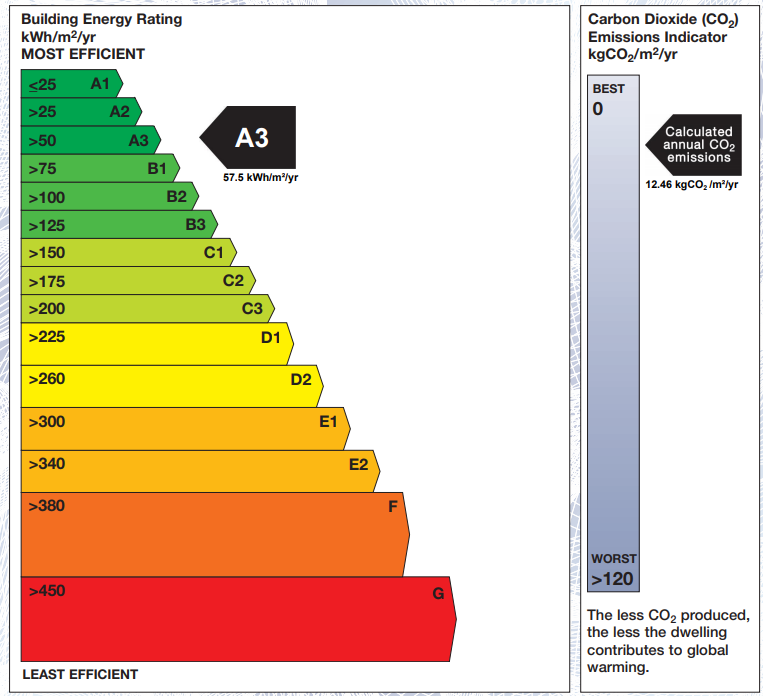
The BER (Building Energy Rating) of our house has gone from D1 consuming 236.42 kWh / sqm / year to A3, consuming 57.5 kWh/m/year. Each and every kWh less of energy our house consumes is money we’re not spending on energy.
I would just reiterate that when we moved into the house 6-7 years ago, the wind literally blew through it. Single glazed windows, no insulation at all, a front door which used to let the wind and rain in. I think why I value these changes so highly is that it’s really difficult to earn more money. And when you do, you pay tax on those earnings. It’s much easier to reduce your costs. So seeing our energy costs fall by €3,925.43 ($4,821) every year into the future removes a lot of stress about money, and makes it much more realistic for us to consider one or both of us retiring early if we want to.
A note on the upfront costs of this work – we were lucky to have been able to save up the cost of these works by pretty relentlessly setting aside all of the savings from our previous changes. Not everyone will be able to get this money together and so I hope this is reflected in how the governments support lower income households. It strikes me that retrofitting insulation, heat pumps and SolarPV as a much more helpful way to help people than some sort of yearly heating/cooling allowance which leave the household broke again next winter. Getting rid of the bills entirely would free up households from this repetitive treadmill, as well as keeping more money in the country that currently flows out to countries who export fossil fuels.
Some Rules that basically apply to anyone in the world
I’m aware that not everyone has enough time or interest to run complex numbers, so here are The Five Energy Cost Obliteration Rules to Live By:
- First off – ditch your car and cycle. A car costs about $5,000 per year between depreciation, tax, insurance, maintenance and fuel. Cycling is insanely good for saving money and once you get used to it, it’s a lot of fun too. This is probably the best thing you can do if you want to reduce your costs, just get rid of a car in favor of cycling
- Insulate your house. I know it’s boring but just to it. It will sit there saving you money for the next 30+ years and will make the house much more pleasant and cozy.
- Switching to an electric car, particularly a second hand EV, will save you a lot of money in the long term in fuel, maintenance and tax costs
- For a family household, SolarPV is a good investment, better than just paying down your mortgage. If you consume little electricity, and there remains no feed-in-tariff, it may not be. But for most people it now is a financially positive investment. If you don’t have an electric car or Heat Pump, install about 2kW. If you do have a Heat Pump and EV, it’s worth installing up to 6kW of capacity if you have space.
- If/when you switch to a heat pump to heat your house, and to an electric car, they will both save you money, and allow you to make further savings from the SolarPV system. They’re all symbiotic investments.
So there you have it. If you want to permanently lower your energy costs into the future, electrify your car and heating with a Heat Pump, and then generate the electricity yourself. It’s saving us $4,821 every year into the future.

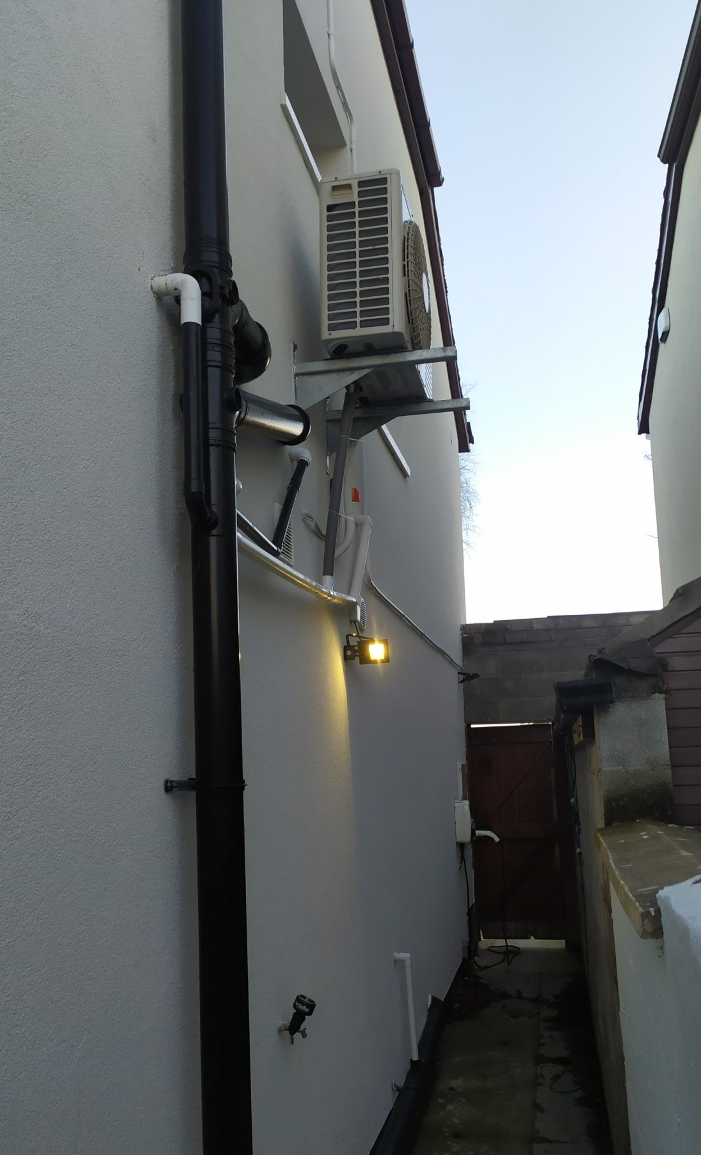
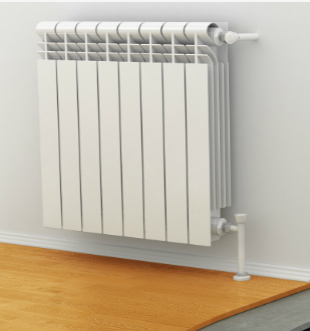

10/10 for this post, informative as ever!